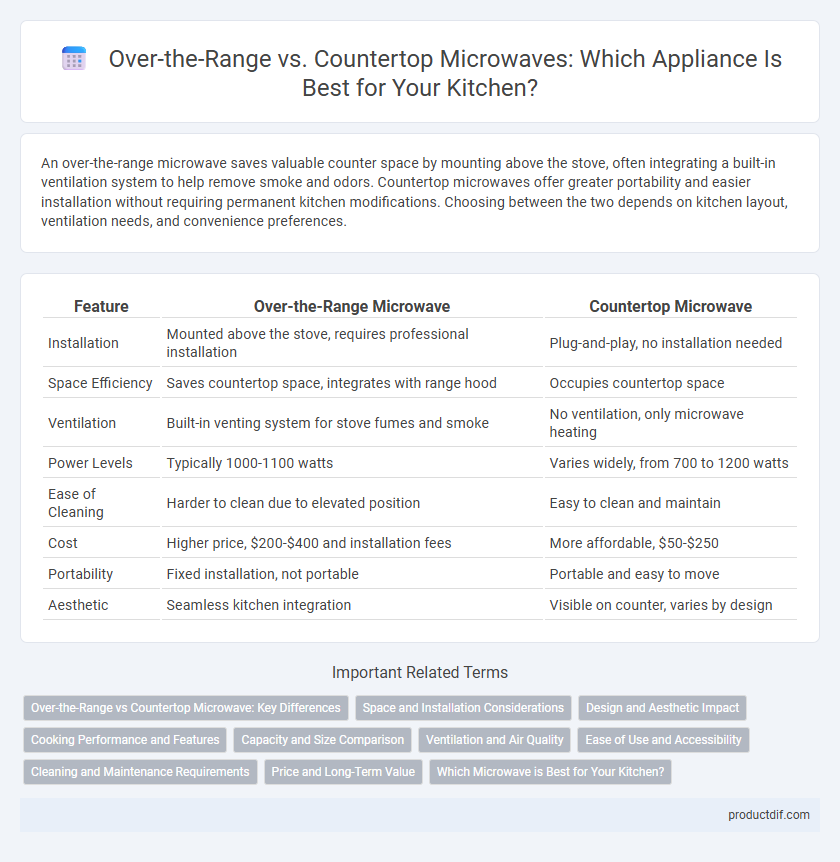An over-the-range microwave saves valuable counter space by mounting above the stove, often integrating a built-in ventilation system to help remove smoke and odors. Countertop microwaves offer greater portability and easier installation without requiring permanent kitchen modifications. Choosing between the two depends on kitchen layout, ventilation needs, and convenience preferences.
Table of Comparison
| Feature | Over-the-Range Microwave | Countertop Microwave |
|---|---|---|
| Installation | Mounted above the stove, requires professional installation | Plug-and-play, no installation needed |
| Space Efficiency | Saves countertop space, integrates with range hood | Occupies countertop space |
| Ventilation | Built-in venting system for stove fumes and smoke | No ventilation, only microwave heating |
| Power Levels | Typically 1000-1100 watts | Varies widely, from 700 to 1200 watts |
| Ease of Cleaning | Harder to clean due to elevated position | Easy to clean and maintain |
| Cost | Higher price, $200-$400 and installation fees | More affordable, $50-$250 |
| Portability | Fixed installation, not portable | Portable and easy to move |
| Aesthetic | Seamless kitchen integration | Visible on counter, varies by design |
Over-the-Range vs Countertop Microwave: Key Differences
Over-the-range microwaves combine cooking functionality with built-in ventilation systems, saving valuable countertop space and providing integrated range hood features. Countertop microwaves offer greater portability and easier installation, allowing flexible placement without permanent fixtures or complex wiring. While over-the-range models require professional installation and are typically more expensive, countertop microwaves are budget-friendly and accessible for renters or those needing multiple units.
Space and Installation Considerations
Over-the-range microwaves save valuable countertop space by mounting above the stove, integrating a venting system that eliminates the need for a separate range hood. Countertop microwaves offer flexible placement without requiring professional installation, ideal for renters or those frequently rearranging their kitchen layout. Choosing between the two depends on available kitchen space, ventilation needs, and installation preferences.
Design and Aesthetic Impact
Over-the-range microwaves integrate seamlessly above the stove, saving counter space and creating a streamlined kitchen appearance with built-in ventilation features that enhance the aesthetic flow. Countertop microwaves offer flexible placement and a variety of styles and finishes, allowing for personalized design choices that complement existing decor. Both options influence kitchen layout and visual balance differently, with over-the-range models providing a sleek, space-efficient look and countertop units enabling versatile design adaptability.
Cooking Performance and Features
Over-the-range microwaves offer space-saving installation with built-in ventilation systems ideal for stovetop odor removal, while countertop microwaves provide portability and typically faster cooking times due to more powerful wattage options. Countertop models often feature larger interior capacities and advanced cooking presets for precise temperature control, enhancing cooking performance. Over-the-range units combine microwave functionality with exhaust hood capabilities, though they may have less power compared to high-end countertop microwaves.
Capacity and Size Comparison
Over-the-range microwaves typically offer larger capacities ranging from 1.5 to 2.0 cubic feet, ideal for cooking bigger meals while saving valuable counter space. Countertop microwaves generally have smaller sizes with capacities between 0.7 to 1.5 cubic feet, making them more portable and suitable for limited spaces. Size-wise, over-the-range models measure approximately 30 inches wide to match standard cabinetry, whereas countertop microwaves vary widely but often occupy a footprint of about 20 inches by 15 inches.
Ventilation and Air Quality
Over-the-range microwaves feature built-in ventilation systems that help remove smoke, steam, and odors directly from the cooking area, improving kitchen air quality. Countertop microwaves lack integrated ventilation, requiring separate exhaust solutions to maintain airflow and reduce airborne contaminants. Choosing an over-the-range model enhances ventilation efficiency by combining microwave functionality with effective venting.
Ease of Use and Accessibility
Over-the-range microwaves save valuable counter space by mounting above the stove, offering easy access without bending, which suits kitchens with limited room. Countertop microwaves provide flexible placement options and are simpler to install, making them more accessible for users who may need to move the appliance frequently. Both types cater to different user preferences, with over-the-range models integrating ventilation features while countertop units excel in portability and straightforward use.
Cleaning and Maintenance Requirements
Over-the-range microwaves often feature built-in ventilation systems requiring regular filter cleaning or replacement to maintain optimal airflow and prevent grease buildup. Countertop microwaves, being portable, allow easier access for thorough interior cleaning and exterior wipe-downs without dismantling parts. Both types benefit from frequent cleaning to prevent odors and ensure longevity, but over-the-range models demand more comprehensive maintenance due to their integrated installation and vent components.
Price and Long-Term Value
Over-the-range microwaves generally cost $300 to $700, offering built-in ventilation and saving countertop space, which adds long-term kitchen efficiency and value. Countertop microwaves range from $50 to $250, providing affordability and portability but often require additional ventilation solutions, potentially increasing long-term expenses. Choosing between these depends on budget, kitchen layout, and whether integrated ventilation and space-saving features justify the higher initial investment.
Which Microwave is Best for Your Kitchen?
Over-the-range microwaves save valuable counter space by combining ventilation and cooking functions, making them ideal for smaller kitchens or those seeking a streamlined design. Countertop microwaves offer greater flexibility in placement and easier installation, which suits users who prioritize convenience or frequently move their appliance. Choosing the best microwave depends on kitchen size, ventilation needs, and preferred cooking habits, ensuring optimal functionality and space management.
Over-the-Range Microwave vs Countertop Microwave Infographic

 productdif.com
productdif.com